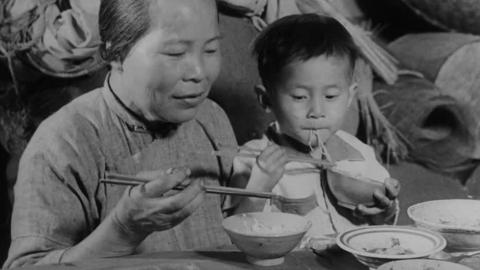This film is part of Free

Formosa Island of Promise
How did Taiwan cope with the huge influx of Chinese refugees from the mainland after the war? This report explains why the island is a symbol of hope for all developing countries.
Overview
As Chiang Kai-shek and his Kuomintang government take stock from their exile in Formosa, and his wife organises a Women’s Anti-Aggression League, the peasant farmers of the island feel the benefit of land reforms instigated by the Chinese government with the aid of the American funded Economic Co-operation Administration. We follow the progress of farmer Liu, whose life has improved as a result of the reforms of the Sino-American Commission for Rural Reconstruction.
This film is a propaganda piece showing how the Economic Co-operation Administration (which also implemented the Marshall Plan) was helping with the reconstruction of Taiwan after the war - and thus aiding the fight against Communism. It also provides a vivid snapshot of Chiang Kai-shek’s first years in Taiwan after he had moved his government to Taipei in 1950. Shots of suspected Communist agents being interrogated and broadcasts to the mainland by the Voice of Free China highlight the film’s anti-Communist message. Not mentioned by the commentary are the tensions that existed between Chiang and the USA, nor the fact that , despite its democratic constitution, Taiwan was essentially a one party state.
Related

Refugee Today and Tomorrow Refugee Today and Tomorrow
Documentary 1938 17 mins
A fierce denunciation of anti-Semitic policies in Nazi Germany seen in the context of the global refugee crisis of 1938.

Return to Life Return to Life
Documentary 1960 29 mins
John Krish’s deeply compassionate documentary on the resettlement of refugees in Britain; made to mark World Refugee Year 1959.

Refuge England Refuge England
Drama 1959 25 mins Location: London
A Hungarian refugee attempts to navigate 1950s London with no English, little money and only an address on a postcard for guidance.

Basque Refugees at Stoneham and a Holiday to Lands End Basque Refugees at Stoneham and a Holiday to Lands End
Amateur film 1937 13 mins Silent
There's something reminiscent in this home movie from the 1930s – with refugees escaping from a distant civil war to find safety in England

Vietnamese Children Refugees Vietnamese Children Refugees
News 1978 5 mins Location: Birmingham
6,000 miles from home, after a perilous voyage to escape terror and oppression, five child refugees from Vietnam experience the magic of a British Christmas.

Refugees in Shanghai: Their Life and Their Education Refugees in Shanghai: Their Life and Their Education
Documentary 1945 28 mins Silent Location: Shanghai
Fascinating, sometimes harrowing record of life in camps run by international aid agencies following the bombing of Shanghai by the Japanese.

All We Imagine As Light - Exclusive Q&A All We Imagine As Light - Exclusive Q&A
Short interview 2025 28 mins
Payal Kapadia discusses her Cannes prize-winning and Bafta-nominated drama with Ashanti Omkar.

Khichdi Khichdi
Animation & Artists Moving Image 2023 16 mins
The interwoven stories of four best friends who reunite in the UK, thirty-five years after training together as nurses during their teens in Ferozepur, Punjab.

Dr XYZ: A Medical Drag Transthology Dr XYZ: A Medical Drag Transthology
Documentary 2023 15 mins
A satirical take on the healthcare service announcements of the 1960s and 70s.

Every Moment Counts Every Moment Counts
Animation & Artists Moving Image 2023 9 mins
A short animation that offers a window into the world of children’s palliative care.

Police Story: Panel Discussion Police Story: Panel Discussion
Inside Film 2024 24 mins
Panel discussion on Jackie Chan's 1985 action classic Police Story, with Chase Armitage, Sam Mak and Jadey Duffield.

China O'Brien: The Reunion China O'Brien: The Reunion
Documentary 2024 60 mins
Cynthia Rothrock, Richard Norton and Keith Cooke reunite three decades on from the groundbreaking martial arts classic.